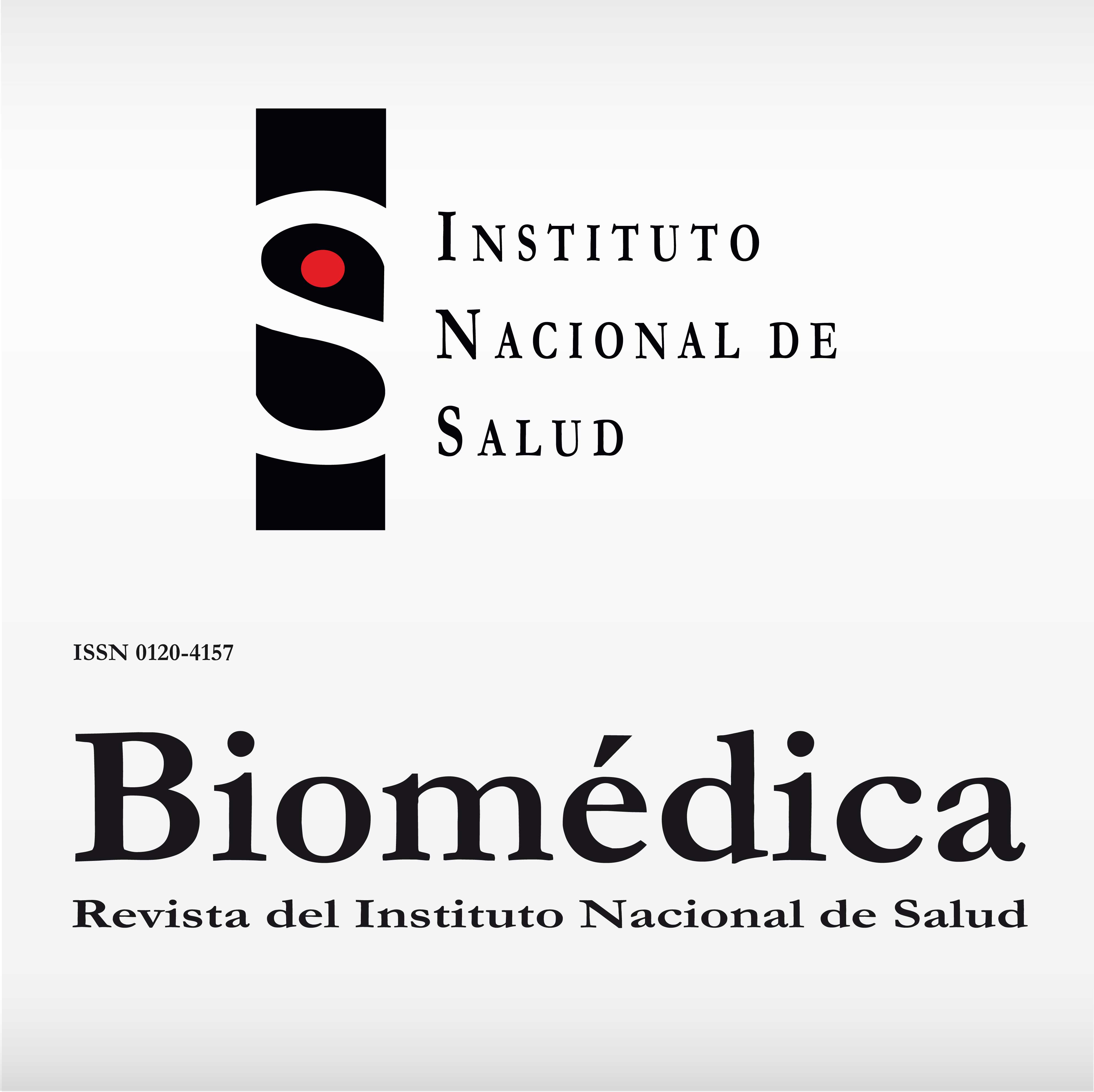Risk factors associated with the development of perinatal asphyxia in neonates at the Hospital Universitario del Valle, Cali, Colombia, 2010-2011
Abstract
Introduction: Perinatal asphyxia is one of the main causes of perinatal mortality and morbidity worldwide and it generates high costs for health systems; however, it has modifiable risk factors.
Objective: To identify the risk factors associated with the development of perinatal asphyxia in newborns at Hospital Universitario del Valle, Cali, Colombia.
Materials and methods: Incident cases and concurrent controls were examined. Cases were defined as newborns with moderate to severe perinatal asphyxia who were older than or equal to 36 weeks of gestational age, needed advanced resuscitation and presented one of the following: early neurological disorders, multi-organ commitment or a sentinel event. The controls were newborns without asphyxia who were born one week apart from the case at the most and had a comparable gestational age. Patients with major congenital malformations and syndromes were excluded.
Results: Fifty-six cases and 168 controls were examined. Premature placental abruption (OR=41.09; 95%CI: 4.61-366.56), labor with a prolonged expulsive phase (OR=31.76; 95%CI: 8.33-121.19), lack of oxytocin use (OR=2.57; 95% CI: 1.08 - 6.13) and mothers without a partner (OR=2.56; 95% CI: 1.21-5.41) were risk factors for the development of perinatal asphyxia in the study population. Social difficulties were found in a greater proportion among the mothers of cases.
Conclusions: Proper control and monitoring of labor, development of a thorough partograph, and active searches are recommended to ensure that all pregnant women have adequate prenatal care with the provision of social support to reduce the frequency and negative impact of perinatal asphyxia.
Downloads
References
Robertson CM, Perlman M. Follow-up of the term infant after hypoxic-ischemic encephalopathy. Paediatr Child Health. 2006;11:278-82.
GBD 2013 Mortality and Causes of Death Collaborators. Global, regional, and national age-sex specific all-cause and cause-specific mortality for 240 causes of death, 1990-2013: A systematic analysis for the Global Burden of Disease Study 2013. Lancet .2015;385:117-71. http://dx.doi.org/10.1016/S0140-6736(14)61682-2
Lawn JE, Cousen S, Zupan J, Lancet Neonatal Survival Steering Team. 4 million neonatal deaths: When? Where? Why? Lancet. 2005;365:891-900. http://dx.doi.org/10.1016/S0140-6736(05)71048-5
García AA, García JA, Blanco BD, Quero JJ, Esqué MT, Figueras AJ. Asfixia perinatal y parálisis cerebral. An Esp Pediatric. 2000;53:40-2.
Moss W, Darmstadt L, Marsh DR, Black RE, Santosham M. Research priorities for the reduction of perinatal and neonatal morbidity and mortality in developing country
communities. J Perinatol. 2002;22:484-95. http://dx.doi.org/10.1038/sj.jp.7210743
Clark SM, Basraon SK, Hankins GD. Intrapartum asphyxia, neonatal encephalopathy, cerebral palsy, and obstetric interventions in the term and near-term infant. NeoReviews. 2013;14:e13-21. http://dx.doi.org/10.1542/neo.14-1-e13
Centro Latinoamericano de Perinatología y Desarrollo Humano, CLAP. Estadísticas de la Región de América Latina y Caribe. Montevideo: CLAP. Fecha de consulta: 29
de marzo de 2005. Disponible en: http://www.clap.ops-oms.org/web_2005/estadisticas%20de%20la%20region/index.htm
Gartner ME. Boletín estadístico neonatal 2007. Comparación primer semestre 2006-2007. Cali: Fundación CIRENA;2007. p. 5-6.
Milsom I, Ladfors L, Thiringer K, Niklasson A, Thornberg E. Influence of maternal, obstetric and fetal risk factors on the prevalence of birth asphyxia at term in a Swedish urban population. Acta Obstet Gynecol Scand. 2002;81:909-17.http://dx.doi.org/10.1034/j.1600-0412.2002.811003.x
Majeed R, Memon Y, Majeed F, Shaikh NP, Rajar UD. Risks factors of birth asphyxia. J Ayub Med Coll Abbottabad. 2007;19:67-71.
Volpe JJ. Hypoxic-ischemic encephalopathy: Clinical aspects. In: Volpe JJ, editor. Neurology of the Newborn. Philadelphia, PA: Elsevier Saunders; 2008. p. 400-80.
Badawi N, Kurinczuk JJ, Keogh JM, Alessandri LM, O’Sullivan F, Burton PR, et al. Intrapartum risk factors for newborn encephalopathy: The Western Australian casecontrol study. BMJ. 1998;317:1554-8.http://dx.doi.org/10.1136/bmj.317.7172.1554
Martínez BM, Madero R, González A, Quero J, García AA. Perinatal morbidity and risk of hypoxic-ischemic encephalopathy associated with intrapartum sentinel events. Am J Obstet Gynecol. 2012;206:148.e1-7. http://dx.doi.org/10.1016/j.ajog.2011.09.031
Ananth CV, Berkowitz GS, Savitz DA, Lapinski RH. Placental abruptio and adverse perinatal outcomes. JAMA. 1999;282:1646-51. http://dx.doi.org/10.1001/jama.282.17.
Ellis M, Manandhar N, Manandhar DS, Costello AM. Risk factors for neonatal encephalopathy in Kathmandu, Nepal, a developing country: Unmatched case control study.
BMJ. 2000;320:1229-36. http://dx.doi.org/10.1136/bmj.320.7244.1229
Hayes BC, McGarvey C, Mulvany S, Kennedy J, Geary MP, Matthews TG, et al. FRCPCH, a case-control study of hypoxic-ischemic encephalopathy in newborn infants at >36
weeks gestation. Am J Obstet Gynecol. 2013;209:e-1-29. http://dx.doi.org/10.1016/j.ajog.2013.03.023
Schoeps D, Almeida MF, Alencar GP, França Jr I, Novaes HM, Siqueira AA, et al. Risk factors for early neonatal mortality. Rev Saúde Pública. 2007;41:1013-22. http://dx.doi.org/10.1590/S0034-89102007000600017
Daripa M, Caldas HM, Flores LP, Waldvogel BC, Guinsburg R, de Almeida MF. Perinatal asphyxia associated with early neonatal mortality: Populational study of
avoidable deaths. Rev Paul Pediatr. 2013;31:37-45. http://dx.doi.org/10.1590/S0103-05822013000100007
Torres J. Caracterización de los recién nacidos con asfixia perinatal en un hospital universitario de tercer nivel en Colombia. Revista Gastrohnup. 2013;15:S4-S11.
Muller AJ, Marks JD. Hypoxic ischemic brain injury: Potential therapeutic interventions for the future. Neoreviews. 2014;15:e177-86. http://dx.doi.org/10.1542/neo.15-5-e177
Some similar items:
- Ricardo García, Franklyn Prieto, Carlos Arenas, Julio Rincón, Sidia Caicedo, Gloria Rey, Reduction of HIV mother-to-child transmission in Colombia, two years of experience, 2003-2005. , Biomedica: Vol. 25 No. 4 (2005)
- Diego Alberto Herrera, Sergio Alberto Vargas, Claudia Montoya, Neuroimaging findings in cerebroretinal microangiopathy with calcifications and cysts , Biomedica: Vol. 34 No. 2 (2014)
- Irene Riveros-Barrera, Zulma Dueñas, Maternal separation during nursing alters basal neuroendocrine levels in juvenile and adult rats , Biomedica: Vol. 36 No. 1 (2016)
- Lorena Alexandra Maldonado-Maldonado, Sandra Patricia Misnaza-Castrillón, Carlos Andrés Castañeda-Orjuela, Inequalities in dental prenatal control in Colombia: An analysis based on the IV National Oral Health Study, 2013-2014 , Biomedica: Vol. 41 No. 2 (2021)

| Article metrics | |
|---|---|
| Abstract views | |
| Galley vies | |
| PDF Views | |
| HTML views | |
| Other views | |

























